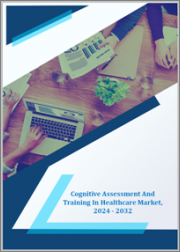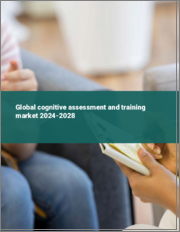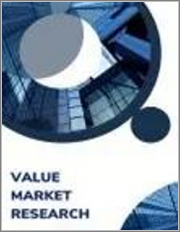
|
시장보고서
상품코드
1519523
세계의 인지 평가 및 트레이닝 시장 보고서 : 평가 유형, 구성요소, 용도, 최종 사용자 분야, 지역별(2024-2032년)Cognitive Assessment and Training Market Report by Assessment Type, Component, Application, End-User Sector, and Region 2024-2032 |
||||||
세계 인지 평가 및 트레이닝 시장 규모는 2023년 47억 달러에 달했습니다. 향후 IMARC 그룹은 2024-2032년간 21.6%의 연평균 성장률(CAGR)을 보이며 2032년까지 286억 달러에 달할 것으로 예측했습니다.
인지 평가 및 트레이닝 솔루션은 인지 기능 장애의 징후를 조기에 발견하는 데 사용됩니다. 이러한 솔루션은 주로 환자의 심리적 기능과 정보 처리 속도에 대한 공식적인 평가를 수행하는 데 사용됩니다. 이러한 장애는 노화, 신경 장애, 약물 및 의약품 노출로 인해 발생할 수 있습니다. 이 솔루션은 평가, 데이터 분석 및 관리를 위한 다양한 도구를 통합하여 인지 트레이닝, 스포츠 관리, 치매 조기 발견 등에 도움이 될 수 있습니다. 임상시험, 강의실 세션, 기업 트레이닝, 연구, 뇌 트레이닝, 진단에 사용됩니다.
노인 인구 증가와 뇌 건강 유지의 중요성에 대한 인식이 높아짐에 따라 시장은 주로 노인 인구 증가에 의해 주도되고 있습니다. 노년층의 치매 유병률이 증가함에 따라 인지 평가 및 트레이닝 솔루션의 도입이 촉진되고 있습니다. 유아의 난독증이나 실독증과 같은 학습 장애 및 장애를 감지하는 솔루션의 사용이 증가하고 있는 것도 성장을 가속하는 요인으로 작용하고 있습니다. 또한, 의료 산업의 다양한 기술 발전과 모바일 기반 IT 시스템의 채택 증가도 시장 성장을 가속하고 있습니다. 예를 들어, 컴퓨터 기반 인지 기능 평가는 자동 채점 기능을 통해 감지 정확도를 높이고 인적 오류 가능성을 최소화하는 데 도움이 됩니다. 이 밖에도 의료비 지출 증가와 광범위한 연구개발(R&D) 활동 등이 시장을 더욱 견인할 것으로 예상됩니다.
본 보고서에서 다룬 주요 질문들
- 세계 인지 평가 및 트레이닝 시장은 지금까지 어떻게 성장해왔고, 앞으로 어떻게 변화할 것인가?
- 주요 지역 시장은 어디인가?
- 코로나19가 전 세계 인지 평가 및 트레이닝 시장에 미친 영향은?
- 평가 유형별 시장 분석은?
- 구성요소별 시장 분석은?
- 용도별 시장 현황은 무엇인가?
- 산업 가치사슬의 다양한 단계는?
- 업계의 주요 촉진요인과 과제는?
- 세계 인지 평가 및 트레이닝 시장의 구조와 주요 진출 기업은?
- 업계의 경쟁은 어느 정도인가?
목차
제1장 서문
제2장 조사 범위와 조사 방법
- 조사 목적
- 이해관계자
- 데이터 소스
- 1차 정보
- 2차 정보
- 시장 추정
- 보텀업 접근
- 톱다운 접근
- 조사 방법
제3장 주요 요약
제4장 서론
- 개요
- 주요 업계 동향
제5장 세계의 인지 평가 및 트레이닝 시장
- 시장 개요
- 시장 실적
- COVID-19의 영향
- 시장 예측
제6장 시장 분석 : 평가 유형별
- 펜 및 종이 기반 평가
- 호스트형 평가
- 생체인식 평가
제7장 시장 분석 : 컴포넌트별
- 솔루션
- 시장 동향
- 주요 종류
- 평가
- 데이터 관리
- 프로젝트 관리
- 데이터 분석 및 리포트
- 기타
- 시장 예측
- 서비스
- 시장 동향
- 주요 종류
- 트레이닝 및 지원
- 컨설팅
- 시장 예측
제8장 시장 분석 : 용도별
- 임상시험
- 교실 학습
- 기업 학습
- 뇌 트레이닝
- 연구
- 기타
제9장 시장 분석 : 최종사용자 분야별
- 트레이닝
- 의료
- 기업
- 스포츠
- 방위
- 기타
제10장 시장 분석 : 지역별
- 북미
- 미국
- 캐나다
- 아시아태평양
- 중국
- 일본
- 인도
- 한국
- 호주
- 인도네시아
- 기타
- 유럽
- 독일
- 프랑스
- 영국
- 이탈리아
- 스페인
- 러시아
- 기타
- 라틴아메리카
- 브라질
- 멕시코
- 기타
- 중동 및 아프리카
- 시장 동향
- 시장 내역 : 국가별
- 시장 예측
제11장 SWOT 분석
- 개요
- 강점
- 약점
- 기회
- 위협
제12장 밸류체인 분석
제13장 Porter의 산업 분석
- 개요
- 바이어의 교섭력
- 공급 기업의 교섭력
- 경쟁 정도
- 신규 진출업체의 위협
- 대체품의 위협
제14장 가격 분석
제15장 경쟁 구도
- 시장 구조
- 주요 기업
- 주요 기업 개요
- CRF Bracket
- Brain Resource Ltd.
- Cambridge Cognition Ltd.
- CogniFit
- Cogstate Ltd.
- ERT Clinical
- ImPACT Applications Inc.
- MedAvante-ProPhase Inc.
- Pearson Education
- Prophase, LLC
- Quest Diagnostics Incorporated
The global cognitive assessment and training market size reached US$ 4.7 Billion in 2023. Looking forward, IMARC Group expects the market to reach US$ 28.6 Billion by 2032, exhibiting a growth rate (CAGR) of 21.6% during 2024-2032.
Cognitive assessment and training solutions are used for detecting the signs of cognitive impairment in the early stages. These solutions are primarily utilized for conducting a formal assessment of the patient's psychological functioning and the speed of information processing. These impairments can be caused by old age, neural disorders and exposure to drugs or medicines. The solutions integrate various tools for assessment, data analysis and management that aid in cognitive training, sports management and early detection of dementia in individuals. They are administered during clinical trials, classroom sessions, corporate teaching, research, brain training and diagnostics.
The market is primarily being driven by the growing geriatric population and increasing awareness regarding the importance of maintaining brain fitness. The rising prevalence of dementia among the elderly is facilitating the adoption of cognitive assessment and training solutions as they enable easy and effective diagnosis and treatment of the disorder. Increasing utilization of the solutions to detect learning difficulties and disabilities, such as dyslexia and dyscalculia in children, is acting as another growth-inducing factor. Additionally, various technological advancements in the healthcare industry and the rising adoption of mobile-based IT systems are also providing a boost to the market growth. For instance, computerized cognitive assessments provide automated scoring, which aids in enhancing the detection accuracy and minimizing the chances of human error. Other factors, including rising healthcare expenditure and extensive research and development (R&D) activities, are projected to drive the market further.
Key Market Segmentation:
IMARC Group provides an analysis of the key trends in each sub-segment of the global cognitive assessment and training market report, along with forecasts at the global, regional and country level from 2024-2032. Our report has categorized the market based on assessment type, component, application and end-user sector.
Breakup by Assessment Type:
Pen- and Paper-Based Assessment
Hosted Assessment
Biometrics Assessment
Breakup by Component:
Solutions
Assessment
Data Management
Project Management
Data Analysis and Reporting
Others
Services
Training and Support
Consulting
Breakup by Application:
Clinical Trials
Classroom Learning
Corporate Learning
Brain Training
Research
Others
Breakup by End-User Sector:
Education
Healthcare
Corporate
Sports
Defense
Others
Breakup by Region:
North America
United States
Canada
Asia Pacific
China
Japan
India
South Korea
Australia
Indonesia
Others
Europe
Germany
France
United Kingdom
Italy
Spain
Russia
Others
Latin America
Brazil
Mexico
Others
Middle East and Africa
Competitive Landscape:
The competitive landscape of the industry has also been examined with some of the key players being CRF Bracket, Brain Resource Ltd., Cambridge Cognition Ltd, Cognifit, Cogstate Ltd., ERT Clinical, ImPACT Applications Inc., MedAvante-ProPhase Inc., Pearson Education, Prophase LLC, Quest Diagnostics Inc., etc.
Key Questions Answered in This Report:
- How has the global cognitive assessment and training market performed so far and how will it perform in the coming years?
- What are the key regional markets?
- What has been the impact of COVID-19 on the global cognitive assessment and training market?
- What is the breakup of the market based on the assessment type?
- What is the breakup of the market based on the component?
- What is the breakup of the market based on the application?
- What is the breakup of the market based on the end-user sector?
- What are the various stages in the value chain of the industry?
- What are the key driving factors and challenges in the industry?
- What is the structure of the global cognitive assessment and training market and who are the key players?
- What is the degree of competition in the industry?
Table of Contents
1 Preface
2 Scope and Methodology
- 2.1 Objectives of the Study
- 2.2 Stakeholders
- 2.3 Data Sources
- 2.3.1 Primary Sources
- 2.3.2 Secondary Sources
- 2.4 Market Estimation
- 2.4.1 Bottom-Up Approach
- 2.4.2 Top-Down Approach
- 2.5 Forecasting Methodology
3 Executive Summary
4 Introduction
- 4.1 Overview
- 4.2 Key Industry Trends
5 Global Cognitive Assessment and Training Market
- 5.1 Market Overview
- 5.2 Market Performance
- 5.3 Impact of COVID-19
- 5.4 Market Forecast
6 Market Breakup by Assessment Type
- 6.1 Pen- and Paper-Based Assessment
- 6.1.1 Market Trends
- 6.1.2 Market Forecast
- 6.2 Hosted Assessment
- 6.2.1 Market Trends
- 6.2.2 Market Forecast
- 6.3 Biometrics Assessment
- 6.3.1 Market Trends
- 6.3.2 Market Forecast
7 Market Breakup by Component
- 7.1 Solutions
- 7.1.1 Market Trends
- 7.1.2 Major Types
- 7.1.2.1 Assessment
- 7.1.2.2 Data Management
- 7.1.2.3 Project Management
- 7.1.2.4 Data Analysis and Reporting
- 7.1.2.5 Others
- 7.1.3 Market Forecast
- 7.2 Services
- 7.2.1 Market Trends
- 7.2.2 Major Types
- 7.2.2.1 Training and Support
- 7.2.2.2 Consulting
- 7.2.3 Market Forecast
8 Market Breakup by Application
- 8.1 Clinical Trials
- 8.1.1 Market Trends
- 8.1.2 Market Forecast
- 8.2 Classroom Learning
- 8.2.1 Market Trends
- 8.2.2 Market Forecast
- 8.3 Corporate Learning
- 8.3.1 Market Trends
- 8.3.2 Market Forecast
- 8.4 Brain Training
- 8.4.1 Market Trends
- 8.4.2 Market Forecast
- 8.5 Research
- 8.5.1 Market Trends
- 8.5.2 Market Forecast
- 8.6 Others
- 8.6.1 Market Trends
- 8.6.2 Market Forecast
9 Market Breakup by End-User Sector
- 9.1 Education
- 9.1.1 Market Trends
- 9.1.2 Market Forecast
- 9.2 Healthcare
- 9.2.1 Market Trends
- 9.2.2 Market Forecast
- 9.3 Corporate
- 9.3.1 Market Trends
- 9.3.2 Market Forecast
- 9.4 Sports
- 9.4.1 Market Trends
- 9.4.2 Market Forecast
- 9.5 Defense
- 9.5.1 Market Trends
- 9.5.2 Market Forecast
- 9.6 Others
- 9.6.1 Market Trends
- 9.6.2 Market Forecast
10 Market Breakup by Region
- 10.1 North America
- 10.1.1 United States
- 10.1.1.1 Market Trends
- 10.1.1.2 Market Forecast
- 10.1.2 Canada
- 10.1.2.1 Market Trends
- 10.1.2.2 Market Forecast
- 10.1.1 United States
- 10.2 Asia Pacific
- 10.2.1 China
- 10.2.1.1 Market Trends
- 10.2.1.2 Market Forecast
- 10.2.2 Japan
- 10.2.2.1 Market Trends
- 10.2.2.2 Market Forecast
- 10.2.3 India
- 10.2.3.1 Market Trends
- 10.2.3.2 Market Forecast
- 10.2.4 South Korea
- 10.2.4.1 Market Trends
- 10.2.4.2 Market Forecast
- 10.2.5 Australia
- 10.2.5.1 Market Trends
- 10.2.5.2 Market Forecast
- 10.2.6 Indonesia
- 10.2.6.1 Market Trends
- 10.2.6.2 Market Forecast
- 10.2.7 Others
- 10.2.7.1 Market Trends
- 10.2.7.2 Market Forecast
- 10.2.1 China
- 10.3 Europe
- 10.3.1 Germany
- 10.3.1.1 Market Trends
- 10.3.1.2 Market Forecast
- 10.3.2 France
- 10.3.2.1 Market Trends
- 10.3.2.2 Market Forecast
- 10.3.3 United Kingdom
- 10.3.3.1 Market Trends
- 10.3.3.2 Market Forecast
- 10.3.4 Italy
- 10.3.4.1 Market Trends
- 10.3.4.2 Market Forecast
- 10.3.5 Spain
- 10.3.5.1 Market Trends
- 10.3.5.2 Market Forecast
- 10.3.6 Russia
- 10.3.6.1 Market Trends
- 10.3.6.2 Market Forecast
- 10.3.7 Others
- 10.3.7.1 Market Trends
- 10.3.7.2 Market Forecast
- 10.3.1 Germany
- 10.4 Latin America
- 10.4.1 Brazil
- 10.4.1.1 Market Trends
- 10.4.1.2 Market Forecast
- 10.4.2 Mexico
- 10.4.2.1 Market Trends
- 10.4.2.2 Market Forecast
- 10.4.3 Others
- 10.4.3.1 Market Trends
- 10.4.3.2 Market Forecast
- 10.4.1 Brazil
- 10.5 Middle East and Africa
- 10.5.1 Market Trends
- 10.5.2 Market Breakup by Country
- 10.5.3 Market Forecast
11 SWOT Analysis
- 11.1 Overview
- 11.2 Strengths
- 11.3 Weaknesses
- 11.4 Opportunities
- 11.5 Threats
12 Value Chain Analysis
13 Porters Five Forces Analysis
- 13.1 Overview
- 13.2 Bargaining Power of Buyers
- 13.3 Bargaining Power of Suppliers
- 13.4 Degree of Competition
- 13.5 Threat of New Entrants
- 13.6 Threat of Substitutes
14 Price Analysis
15 Competitive Landscape
- 15.1 Market Structure
- 15.2 Key Players
- 15.3 Profiles of Key Players
- 15.3.1 CRF Bracket
- 15.3.1.1 Company Overview
- 15.3.1.2 Product Portfolio
- 15.3.2 Brain Resource Ltd.
- 15.3.2.1 Company Overview
- 15.3.2.2 Product Portfolio
- 15.3.3 Cambridge Cognition Ltd.
- 15.3.3.1 Company Overview
- 15.3.3.2 Product Portfolio
- 15.3.4 CogniFit
- 15.3.4.1 Company Overview
- 15.3.4.2 Product Portfolio
- 15.3.5 Cogstate Ltd.
- 15.3.5.1 Company Overview
- 15.3.5.2 Product Portfolio
- 15.3.5.3 Financials
- 15.3.6 ERT Clinical
- 15.3.6.1 Company Overview
- 15.3.6.2 Product Portfolio
- 15.3.7 ImPACT Applications Inc.
- 15.3.7.1 Company Overview
- 15.3.7.2 Product Portfolio
- 15.3.8 MedAvante-ProPhase Inc.
- 15.3.8.1 Company Overview
- 15.3.8.2 Product Portfolio
- 15.3.9 Pearson Education
- 15.3.9.1 Company Overview
- 15.3.9.2 Product Portfolio
- 15.3.9.3 SWOT Analysis
- 15.3.10 Prophase, LLC
- 15.3.10.1 Company Overview
- 15.3.10.2 Product Portfolio
- 15.3.11 Quest Diagnostics Incorporated
- 15.3.11.1 Company Overview
- 15.3.11.2 Product Portfolio
- 15.3.11.3 SWOT Analysis
- 15.3.1 CRF Bracket


















